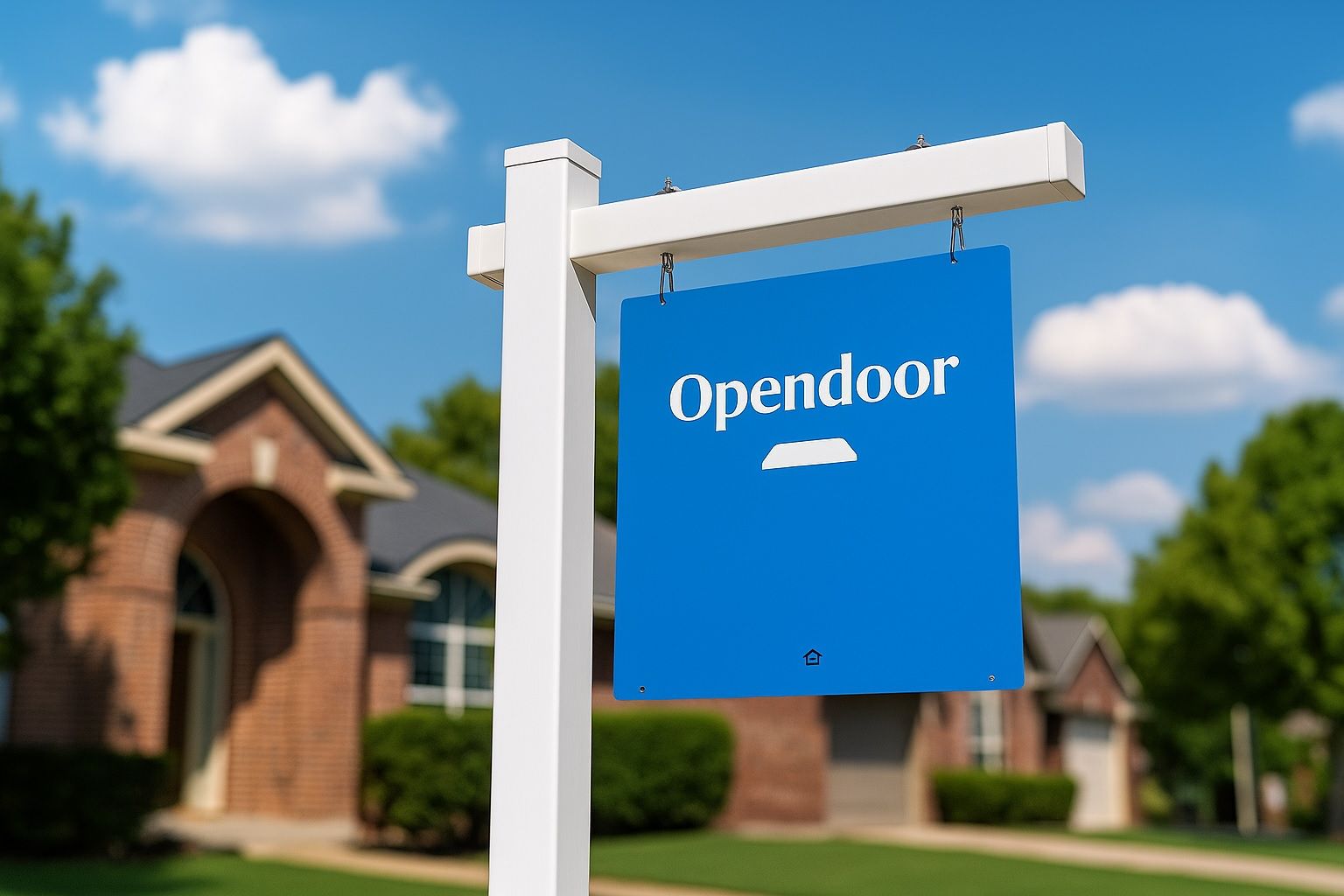- Stunning Rally: Opendoor Technologies (NASDAQ: OPEN) shares have surged roughly 350–450% in 2025, trading around $7.20 as of early November [1] [2]. The stock recently jumped 13% in one day to ~$7.97 on hopes of Fed interest rate cuts [3], reflecting renewed investor enthusiasm after a brutal 2022–2023 slump.
- Latest Buzz: The company is reinventing its earnings calls with a livestreamed “Financial Open House” on platforms like Robinhood, letting shareholders submit questions [4]. Major Wall Street players are taking note – Morgan Stanley hiked its price target from $2 to $6 (Hold rating) ahead of Q3 results [5], though the stock still trades above most analyst targets.
- Turnaround in Progress: Opendoor posted $1.6 billion revenue in Q2 2025 (up 4% YoY) with its first positive Adjusted EBITDA since 2022 [6]. Net loss narrowed sharply (just $29 million vs $92 million a year prior) [7] as the firm cut costs and refined operations. However, housing market headwinds saw Q3 revenue guidance slashed to ~$800–875 million with a return to modest losses expected [8].
- Housing Market Impact:Rising mortgage rates in early 2025 froze home sales, but rates have since eased to ~6.2% (a one-year low) after Fed rate cuts [9] [10]. This improving outlook has buoyed real estate stocks like Opendoor – investors anticipate that lower borrowing costs will “unlock” homebuyer demand and boost Opendoor’s flipping volumes [11] [12]. Still, transaction volumes remain historically subdued, testing Opendoor’s model until a broader housing recovery takes hold.
- Leadership & Strategy Shifts: In a dramatic September shake-up, co-founders Eric Wu and Keith Rabois returned to Opendoor’s board, and tech exec Kaz Nejatian was appointed CEO, replacing Carrie Wheeler amid investor pressure [13]. The new leadership is expected to pursue a more aggressive turnaround. Opendoor is expanding partnerships with real estate agents, aiming to offer “multiple solutions” to home sellers and generate capital-light revenue streams [14] – a pivot from pure home-flipping toward a hybrid platform model.
- Competitive Landscape: Opendoor stands as the leading iBuyer after rivals pulled back. Zillow and Redfin exited the home-flipping business (Zillow now partners with Opendoor to provide cash offers on its site [15]), and Redfin shut down its RedfinNow program in 2022. Smaller rival Offerpad remains in the game but at a fraction of Opendoor’s scale – e.g. Offerpad’s Q1 2025 revenue was just $160 million vs Opendoor’s $1.2 billion [16]. Both iBuyers have been narrowing losses, but Opendoor’s nationwide reach (over 20 markets) and tech-driven pricing give it a dominant position to capitalize on a housing rebound.
- Analyst Outlook & Risks:Wall Street is divided. Despite the year’s rally, the consensus rating is only “Hold” and many analysts remain skeptical of sustainability [17]. In fact, as of late summer the stock was trading at more than double the Street’s highest target (then $2) [18], though Morgan Stanley’s new $6 target is a bullish uptick [19]. Bears like Citi see further downside (with targets under $1) amid volatile housing trends [20]. Bulls, however, point to Opendoor’s improved unit economics and tech platform – some go so far as to imagine the stock “skyrocketing to $20” under favorable conditions [21], or even 10x growth in five years with the new CEO’s vision [22]. Such rosy scenarios hinge on Opendoor achieving consistent profitability and growth as the real estate cycle turns.
- Bottom Line:Opendoor’s 2025 comeback encapsulates both the promise and peril of disruptive real estate tech. The stock’s explosive gains reflect returning confidence – fueled by insider buys, a high-profile stake from Jane Street (5.9% ownership) as a “vote of confidence” [23] [24], and even a dose of meme-stock frenzy via social media buzz [25]. Moving forward, investors are watching Q3 earnings (Nov 6) and beyond for proof that Opendoor can thrive in a cooling market. If mortgage rates continue to fall and home sellers re-engage, Opendoor’s streamlined operations and new agent-partner approach could drive a second act of growth. However, significant risks remain – from potential home price declines to the company’s still-thin profit margins and hefty housing inventory on its books. In short, Opendoor has opened the door to a new chapter, but it must execute well in a challenging real estate climate to justify the hype.
Opendoor at a Glance: Recent Financials (Q2 2025)
| Metric | Q2 2025 | Q2 2024 |
|---|---|---|
| Revenue | $1.57 billion [26] | $1.51 billion (est.) [27] |
| Homes Sold | 4,299 [28] | ~4,090 [29] |
| Net Loss (GAAP) | $(29)$ million [30] | $(92)$ million [31] |
| Adjusted EBITDA | +$23 million [32] | $(5)$ million [33] |
Source: Company filings and shareholder letter. Opendoor achieved its first Adjusted EBITDA profit in Q2 2025 since 2022, even as the housing market “continued to deteriorate,” according to the company [34]. However, management guided for a return to negative EBITDA in Q3 amid lower expected revenue [35].
Recent Developments and News
A cooled housing market in 2023–2024 set the stage for Opendoor’s dramatic rebound in 2025, as investors bet on a turnaround in real estate conditions. [36] [37]
- Innovative Earnings Calls: Opendoor is breaking the mold in how it communicates with investors. Instead of a traditional closed conference call, the company will host a live-streamed earnings presentation (“Financial Open House”) for its Q3 2025 results [38]. The stream – on Robinhood’s platform, social media (X/Twitter, YouTube), and the IR site – will allow shareholders to submit and upvote questions, with management addressing the top queries live [39]. This move, unveiled on Oct. 30, 2025, aims to boost transparency and retail investor engagement, fitting for a stock that has attracted a large online following. Analysts say this could be a “game changer” in building investor trust [40], though its success will depend on management’s execution and the substance of their answers.
- Major Stake & CEO Change: In late September, Jane Street Capital – a prominent quantitative trading firm – disclosed a 5.9% stake in Opendoor, injecting over $300 million in fresh funds [41]. The news sent OPEN stock up 10%+ to over $9 [42], as investors saw the stake as validation of Opendoor’s prospects [43]. Almost simultaneously, Opendoor announced a leadership shake-up: co-founder Eric Wu (Opendoor’s first CEO) and founding exec Keith Rabois rejoined the board, and Kaz Nejatian (a former Shopify executive) took the helm as the new CEO [44]. This followed the resignation of CEO Carrie Wheeler after investors clamored for bolder action [45]. The return of Wu and Rabois – tech visionaries in real estate – and Nejatian’s appointment signal a push to reignite growth. Insiders suggest Nejatian will focus on scaling Opendoor’s platform more aggressively (Rabois is known for favoring growth over caution [46]). Indeed, Opendoor’s president and even Eric Wu himself have been buying shares on the open market in recent months, a vote of confidence in the turnaround plan [47] [48].
- Analyst and Investor Sentiment: Opendoor’s wild ride in 2025 has split opinions. Morgan Stanley’s analysts notably upgraded their outlook on Oct. 20, raising the price target 3x from $2 to $6 and maintaining an Equal-Weight (Hold) stance [49] – making $6 the highest official target on Wall Street. They cited Opendoor’s improving unit economics and the upcoming Q3 results as rationale [50]. On the flip side, Citigroup and Keefe, Bruyette & Woods remain bearish, recently assigning sub-$1 targets and Sell/Underperform ratings, wary of further losses in the second half and execution risks in Opendoor’s new platform strategy [51] [52]. The average analyst price target sits in the low single-digits, well below the current market price – a stark gap indicating Wall Street’s skepticism [53]. Short interest has also been elevated, as some investors question whether Opendoor’s model can consistently work. However, retail traders and online forums have rallied behind OPEN, especially after the stock’s inclusion in a popular “meme stock” ETF and chatter about AI-powered home valuations [54] [55]. In fact, Opendoor was sometimes grouped with high-flying speculative stocks in 2025’s risk-on rallies [56] [57]. This retail momentum – plus hopes of a short squeeze – helped drive the stock’s stunning year-to-date climb [58]. The key for Opendoor will be validating this optimism with real financial results in coming quarters.
- Real Estate Market Trends: Opendoor’s fortunes are tightly linked to U.S. housing trends. In 2023–2024, surging mortgage rates (peaking ~7%) froze the housing market, leading to very low inventory and sales volumes – a tough environment for an iBuyer that relies on transaction velocity. Many homeowners with ultra-low mortgage rates chose not to sell, and buyer affordability hit decades-low levels. Opendoor responded by drastically scaling back home purchases (acquisitions in Q2 2025 were down 63% YoY [59]) to avoid overextending in a falling market. By late 2025, there are signs of thawing: the Fed has reversed course and cut interest rates (0.25% cut on Oct. 29, 2025) as inflation eased [60]. Mortgage rates have dipped to ~6.1–6.3% – the lowest in over a year [61] – which is gradually bringing some buyers back. September 2025 saw a slight uptick (+1.5%) in existing-home sales nationally, per NAR data, and home prices are projected to rise ~3% in 2025 on average [62] [63] (no crash in sight given persistent housing shortages). For Opendoor, a stabilizing or rebounding market is crucial: more sales mean more opportunities to flip homes, and modest home price appreciation can boost margins (whereas sharp declines would spell trouble). The company itself noted “a consistent slowing of the housing market as the quarter progressed” in Q2 [64], and its cautious Q3 outlook reflects those conditions. If the Fed’s easing cycle continues into 2026, analysts expect housing activity to pick up significantly – a tailwind that could benefit Opendoor’s volumes. Conversely, if high rates linger or the economy slips into recession, real estate could stagnate, testing Opendoor’s resilience.
Business Performance and Financial Health
Opendoor’s latest financial results show marked improvement from the crisis it navigated in 2022–23, though the business is not fully out of the woods. In Q2 2025, Opendoor generated $1.57 billion in revenue, up slightly (4%) from the prior year [65] – a notable return to growth after revenues plunged in 2023 when the company slashed inventory to reduce risk. It sold 4,299 homes in Q2, also up ~5% YoY [66], and purchased 1,757 homes to replenish its inventory (still a much slower acquisition rate than before). Gross profit held roughly flat at $128 million, about an 8.2% gross margin [67] – indicating Opendoor is maintaining careful pricing discipline on its flips even in a slow market. Most encouraging, Adjusted EBITDA (a measure of core operating profitability) came in at +$23 million for Q2 [68]. This is a sharp turnaround from losses and the first positive EBITDA quarter since 2022 [69] [70]. It suggests Opendoor’s cost cuts (including layoffs and marketing pullbacks in 2023) and more cautious pricing of homes have paid off. The company’s net loss also narrowed to just $29 million in Q2, compared to a $92 million loss a year earlier [71]. In fact, excluding certain one-time items, Opendoor was nearly breakeven on an adjusted net income basis [72].
Bolstering its stability, Opendoor’s balance sheet and liquidity position have improved. Free cash flow turned positive in Q2 (+$821 million) as the firm wound down old inventory and sold more homes than it bought [73]. Opendoor ended June 2025 with $789 million in cash on hand (unrestricted) plus about $396 million in restricted cash, and $1.5 billion in salable housing inventory [74]. Moreover, in May 2025 Opendoor restructured $325 million of convertible debt, extending its maturities and shoring up capital [75]. These moves give the company financial breathing room. Leverage remains a concern for all iBuyers – Opendoor carries billions in short-term home financing credit – but the company has emphasized that its debt is matched to assets (homes) and that it can adjust the pace of buying to avoid cash crunches. With the new equity infusion from Jane Street and others, Opendoor appears reasonably capitalized for the near term.
That said, Q3 2025 is expected to be weak due to the housing cooldown over summer. Opendoor pre-announced a big drop in revenue to ~$800–875 million for Q3 [76] – roughly half the level of Q2’s sales. This reflects the low number of homes it chose to buy and sell amid market uncertainty (the company can only recognize revenue on homes sold, and it started Q3 with a much smaller inventory). Consequently, Opendoor guided that it would lose $21–28 million (Adj. EBITDA) in Q3 [77], essentially giving back some of Q2’s profit. This see-saw pattern underscores the challenge: Opendoor can swing to profit in strong selling periods but fall back to losses when it throttles activity. Longer-term, management’s goal is to smooth this out by diversifying revenue streams and using its pricing algorithms to weather market swings. Shareholders will scrutinize the Q3 earnings release on Nov 6 for any updates to full-year outlook and clues on whether Q4 will rebound now that mortgage rates are easing.
Opendoor’s Evolving Strategy and Competitive Position
Opendoor pioneered the iBuyer model – using algorithms to make instant home purchase offers, then reselling houses for a fee. This “fast flip” model was tested like never before in 2022 when home prices turned sharply downward, leading to heavy losses as Opendoor sold many homes for less than it paid. Zillow’s high-profile failure in iBuying (shutting its Zillow Offers division in 2021 after losing $500+ million) highlighted the model’s risks [78] [79]. Opendoor survived the storm by quickly reducing inventory and retooling its approach. Now, under new leadership, the company is shifting toward a hybrid platform strategy that goes beyond flipping its own homes.
A key initiative is the “trusted agent partner” program, where Opendoor collaborates with traditional real estate agents [80] [81]. If a homeowner requests an Opendoor offer but it’s not a fit (for example, price too high or outside Opendoor’s buy criteria), Opendoor can refer the seller to a partner agent in their area. Those agents, in turn, help sell the home on the open market while Opendoor gets a referral fee or a cut of the commission. Opendoor’s CEO in Q1 described it as “flipping the script” – instead of just agents bringing clients to Opendoor, Opendoor now brings leads to agents, monetizing customers it would otherwise turn away [82] [83]. The company ran a pilot in 11 markets and saw promising results. This agent-centric approach is a significant evolution of Opendoor’s model: it’s capital-light (no home purchase required) and expands the addressable market of sellers Opendoor can earn revenue from [84]. It does mean Opendoor shares some upside with agents, but it hedges against housing downturns (if Opendoor doesn’t want to take on the risk of owning a home, it can still profit by referring it out). Rival Offerpad has adopted a similar agent referral strategy [85], validating the concept.
Opendoor is also pursuing other services to boost margins – for instance, offering home financing and title services to buyers, and exploring a marketplace for homes (Opendoor Exclusives, an online portal for off-market listings). However, the company put its “Exclusives” home marketplace on hold in late 2024 due to the market pullback [86]. The focus in 2025 is squarely on improving the core offer and sell experience and scaling through partnerships, rather than launching risky new programs. As CEO Nejatian takes over, investors will watch for how he balances growth vs. profitability. His predecessor Wheeler was praised for stabilizing the ship and cutting losses; now the mandate may shift to regaining market share and revenue growth, especially once housing conditions improve.
In terms of competition, Opendoor’s main direct competitor is Offerpad (NYSE: OPAD), another pure-play iBuyer. Offerpad is much smaller – Opendoor’s revenues are about 8–10x larger than Offerpad’s on a quarterly basis [87]. Offerpad too endured steep losses in 2022 and has retrenched to its core markets (mostly Sun Belt cities). Interestingly, Offerpad has managed to stay afloat and, like Opendoor, reported improved results recently (e.g. Q1 2025 net loss $15 M vs $17.5 M prior [88]). Both companies are chasing the path to consistent profitability and often face the same headwinds (interest rates, home price volatility). It’s not uncommon for their stocks to trade in tandem. In fact, Offerpad’s share price leapt in sympathy with Opendoor’s meme-stock rallies, highlighting how tied their narratives are [89]. However, Opendoor’s far greater scale and data advantage (millions of home offers and transactions feeding its AI pricing models) give it a competitive edge if the iBuying model proves viable long-term. Economies of scale matter in this business – larger volume can spread fixed costs and provide more pricing accuracy.
Meanwhile, Zillow (NASDAQ: Z) and Redfin (NASDAQ: RDFN), two big real estate tech names, have pivoted away from direct home-buying. Zillow’s ill-fated Zillow Offers program ended in 2021, and Zillow has since partnered with Opendoor instead. On Zillow’s website today, home sellers in select markets can click “Get a cash offer” and receive an Opendoor offer alongside an estimate of their home’s sale price via a traditional listing [90]. Zillow essentially acts as a lead source for Opendoor (calling it a “trusted partner” [91]), which is a win-win: Zillow earns referral fees and keeps users on its platform, while Opendoor gains efficient access to motivated sellers. Redfin, for its part, shut down its RedfinNow iBuyer operations in late 2022 amid heavy losses and has refocused on its brokerage and portal services [92]. Redfin now sometimes partners with Opendoor as well for seller options. The bottom line is that Opendoor has emerged as the last major iBuyer standing with national scale. This could position it strongly if iBuying proves to be the future of real estate transactions – or it could underscore that even giants like Zillow deemed the model too risky. Opendoor will have to prove, through cycles, that it can buy and sell homes better than a traditional market participant.
Forecast: What’s Next for OPEN Stock?
Looking ahead, Opendoor’s stock faces both catalysts and challenges. In the short term (next 3–6 months), a lot rides on whether the company can meet or beat its targets for Q3 and the all-important spring selling season of 2026. Any sign of renewed growth – for example, a strong Q4 guidance or positive metrics on its agent-partner deals – could fuel further optimism. With the Federal Reserve now tilting dovish, mortgage rates might continue to fall into 2026, potentially reinvigorating home sales. This scenario would be bullish for Opendoor: higher volume and possibly some home price appreciation could let it expand acquisitions again (management has indicated they will scale inventory back up when conditions are right). Some analysts have set 12-month price targets in the high-single digits to low-teens if things go well, noting that the stock could have more room to run given its still relatively low absolute price. For instance, one bullish analysis outlined a path for OPEN to reach $20 per share – roughly triple the current price – if Opendoor can capture a larger share of home sellers and return to its pre-2022 growth trajectory [93]. That would likely require a few years of favorable market trends and flawless execution, including possibly entering new markets and adjacencies (like international expansion or deeper integration of financing options).
Over the long term (next 2–5 years), the vision for Opendoor is to become a real estate marketplace powerhouse – essentially, the “Amazon of housing” where one can quickly sell a home at a fair price or buy one conveniently online. If the company succeeds, it could justify substantial upside beyond current levels. Optimists point to the enormous addressable market (real estate is a $2 trillion+ annual U.S. market by transaction value) and Opendoor’s first-mover advantage. A Motley Fool commentator even mused whether the new CEO could 10X the stock in five years by executing on an AI-driven, platform-centric strategy [94]. Potential drivers for such growth include: expanding into most U.S. cities, improving profit margins per home through better algorithms, offering adjacent services (mortgages, renovations) for additional revenue, and benefiting from network effects with agents and buyers.
However, risks abound on that long road. Housing is cyclical and notoriously unpredictable – a sharp recession or a scenario of prolonged 7–8% mortgage rates could stagnate Opendoor’s business or force it into fire-sales of inventory (as happened in 2022). Competition could re-emerge: if iBuying gains traction in a better market, new entrants or well-funded players (perhaps Zillow, or even institutional investors) might step in with their own cash-offer platforms, squeezing margins. Additionally, while Opendoor has improved its models, pricing homes for slim profits remains a razor-thin business – one bad bet on market direction can wipe out the gains on many other deals. The company’s gross margin of ~8% leaves little room for error if home prices shift. Regulatory and consumer preference trends also matter; there’s some debate if homeowners truly want to sell to an algorithm at a discount, or if most will still opt for an agent when feasible.
From a stock perspective, OPEN is not for the faint of heart. It has shown meme-like volatility, surging and plunging rapidly on sentiment. Investors who believe in Opendoor’s vision need to be prepared for choppy waters. Those on the sidelines might await clearer proof of sustainable profits (perhaps a few consecutive profitable quarters) before jumping in – a point even bullish analysts concede [95]. For now, analysts’ median estimates foresee Opendoor continuing to post net losses through 2025, with a potential return to GAAP profitability by 2026 or 2027 if all goes well [96] [97]. Price targets range widely (from under $1 to $6+ as noted), reflecting high uncertainty.
In summary, Opendoor Technologies has staged a remarkable recovery in 2025, with its stock quintupled and its business model adapting in real-time to a changing market. The company’s bold moves – from streaming its earnings call to revamping leadership – underscore a willingness to break the mold in an antiquated industry. If the U.S. housing market gains momentum in 2026 and Opendoor can deftly manage its growth, the stock’s story could evolve from a short-term speculative frenzy into a sustainable long-term success narrative. For the public and investors alike, the coming quarters will be telling: can Opendoor deliver on the promise of a simpler, modern way to sell homes and turn that into profits? The answer will likely determine whether OPEN stock’s epic 2025 rally marks just the beginning or the peak of its comeback.
Sources: Bloomberg; Yahoo Finance; GlobeNewswire (Opendoor Investor Relations) [98] [99]; Insider Monkey [100] [101]; Barchart [102] [103]; Motley Fool via Nasdaq [104]; CBS News [105] [106]; Real Estate News [107] [108]; Zillow.com [109]; Insider Monkey (Market news and analyst commentary) [110] [111].
References
1. www.barchart.com, 2. www.marketbeat.com, 3. www.insidermonkey.com, 4. www.insidermonkey.com, 5. www.insidermonkey.com, 6. www.barchart.com, 7. www.globenewswire.com, 8. www.barchart.com, 9. www.cbsnews.com, 10. www.cbsnews.com, 11. www.insidermonkey.com, 12. www.insidermonkey.com, 13. www.insidermonkey.com, 14. www.globenewswire.com, 15. www.zillow.com, 16. www.realestatenews.com, 17. www.barchart.com, 18. www.barchart.com, 19. www.insidermonkey.com, 20. www.barchart.com, 21. www.marketbeat.com, 22. www.marketbeat.com, 23. www.insidermonkey.com, 24. www.insidermonkey.com, 25. www.barchart.com, 26. www.barchart.com, 27. www.globenewswire.com, 28. www.globenewswire.com, 29. www.globenewswire.com, 30. www.globenewswire.com, 31. www.globenewswire.com, 32. www.barchart.com, 33. www.barchart.com, 34. www.globenewswire.com, 35. www.barchart.com, 36. www.insidermonkey.com, 37. www.cbsnews.com, 38. www.insidermonkey.com, 39. www.insidermonkey.com, 40. finance.yahoo.com, 41. www.insidermonkey.com, 42. www.insidermonkey.com, 43. www.marketbeat.com, 44. www.insidermonkey.com, 45. www.insidermonkey.com, 46. www.insidermonkey.com, 47. www.barchart.com, 48. www.insiderscreener.com, 49. www.insidermonkey.com, 50. www.insidermonkey.com, 51. www.barchart.com, 52. www.barchart.com, 53. www.barchart.com, 54. www.marketbeat.com, 55. www.marketbeat.com, 56. www.bloomberg.com, 57. www.bloomberg.com, 58. www.barchart.com, 59. www.globenewswire.com, 60. www.cbsnews.com, 61. www.cbsnews.com, 62. www.jpmorgan.com, 63. www.jpmorgan.com, 64. www.barchart.com, 65. www.barchart.com, 66. www.barchart.com, 67. www.globenewswire.com, 68. www.barchart.com, 69. www.globenewswire.com, 70. www.barchart.com, 71. www.globenewswire.com, 72. www.globenewswire.com, 73. www.barchart.com, 74. www.barchart.com, 75. www.barchart.com, 76. www.barchart.com, 77. www.barchart.com, 78. www.homelight.com, 79. sellwithdealmate.com, 80. www.realestatenews.com, 81. www.realestatenews.com, 82. www.realestatenews.com, 83. www.realestatenews.com, 84. www.globenewswire.com, 85. www.realestatenews.com, 86. www.realestatenews.com, 87. www.realestatenews.com, 88. www.realestatenews.com, 89. www.sahmcapital.com, 90. www.zillow.com, 91. www.zillow.com, 92. www.geekwire.com, 93. www.marketbeat.com, 94. www.marketbeat.com, 95. www.barchart.com, 96. www.barchart.com, 97. www.barchart.com, 98. www.globenewswire.com, 99. www.globenewswire.com, 100. www.insidermonkey.com, 101. www.insidermonkey.com, 102. www.barchart.com, 103. www.barchart.com, 104. www.nasdaq.com, 105. www.cbsnews.com, 106. www.cbsnews.com, 107. www.realestatenews.com, 108. www.realestatenews.com, 109. www.zillow.com, 110. www.insidermonkey.com, 111. www.barchart.com







